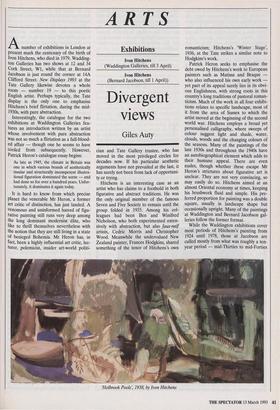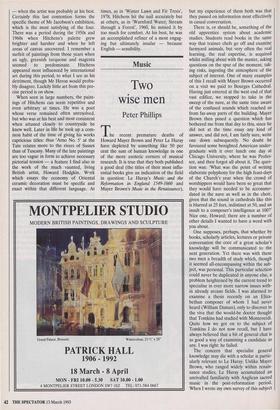ARTS
Exhibitions
Ivon Hitchens (Waddington Galleries, till 3 April) Ivon Hitchens (Bernard Jacobson, till 1 April))
Divergent views
Giles Auty
Anumber of exhibitions in London at present mark the centenary of the birth of Ivon Hitchens, who died in 1979. Wadding- ton Galleries has two shows at 12 and 34 Cork Street, Wl, while that at Bernard Jacobson is just round the corner at 14A Clifford Street. New Displays 1993 at the Tate Gallery likewise devotes a whole room — number 19 — to this poetic English artist. Perhaps typically, the Tate display is the only one to emphasise Hitchens's brief flirtation, during the mid- 1930s, with pure abstraction.
Interestingly, the catalogue for the two exhibitions at Waddington Galleries fea- tures an introduction written by an artist whose involvement with pure abstraction was not so much a flirtation as a full-blood- ed affair — though one he seems to have cooled from subsequently. However, Patrick Heron's catalogue essay begins:
As late as 1945, the climate in Britain was one in which various brands of aesthetically insular and structurally incompetent illustra- tional figuration dominated the scene — and had done so for over a hundred years. Unfor- tunately, it dominates it again today.
It is hard to know from which precise Planet the venerable Mr Heron, a former art critic of distinction, has just landed. A venomous and uninformed hatred of figu- rative painting still runs very deep among the long dominant modernist elite, who like to thrill themselves nevertheless with the notion that they are still living in a state of besieged Bohemia. Mr Heron has, in fact, been a highly influential art critic, lec- turer, polemicist, insider art-world politi- cian and Tate Gallery trustee, who has moved in the most privileged circles for decades now. If his particular aesthetic arguments have not prevailed at the last, it has surely not been from lack of opportuni- ty or trying. Hitchens is an interesting case as an artist who has claims to a foothold in both figurative and abstract traditions. He was the only original member of the famous Seven and Five Society to remain until the group folded in 1935. Among his col- leagues had been Ben and Winifred Nicholson, who both experimented exten- sively with abstraction, but also faux-naif artists, Cedric Morris and Christopher Wood. Meanwhile the undervalued New Zealand painter, Frances Hodgkins, shared something of the tenor of Hitchens's own romanticism; Hitchens's 'Winter Stage', 1936, at the Tate strikes a similar note to Hodgkins's work.
Patrick Heron seeks to emphasise the debt owed by Hitchens's work to European painters such as Matisse and Braque who also influenced his own early work yet part of its appeal surely lies in its obvi- ous Englishness, with strong roots in this country's long traditions of pastoral roman- ticism. Much of the work in all four exhibi- tions relates to specific landscape, most of it from the area of Sussex to which the artist moved at the beginning of the second world war. Hitchens employs a broad yet personalised calligraphy, where sweeps of colour suggest light and shade, water, clouds, woods and the changing colours of the seasons. Many of the paintings of the late 1930s and throughout the 1940s have an autobiographical element which adds to their humane appeal. There are even nudes, though whether these escape Mr Heron's strictures about figurative art is unclear. They are not very convincing, so may easily do so. Hitchens aimed at an almost Oriental economy at times, keeping his brushwork fluid and simple. His pre- ferred proportion for painting was a double square, usually in landscape shape but occasionally upright. Many of the paintings at Waddington and Bernard Jacobson gal- leries follow the former format.
While the Waddington exhibitions cover most periods of Hitchens's painting from 1924 until 1978, those at Jacobson are culled mostly from what was roughly a ten- year period — mid-Thirties to mid-Forties Holbrook Pools', 1938, by Ivon Hitchens — when the artist was probably at his best. Certainly this last contention forms the specific theme of Mr Jacobson's exhibition, which is the most satisfying of the four. There was a period during the 1950s and 1960s when Hitchens's palette grew brighter and harsher and when he left areas of canvas uncovered. I remember a surfeit of paintings from those years when an ugly, greenish turquoise and magenta seemed to predominate. Hitchens appeared most influenced by international art during this period, to what I see as his detriment, though Mr Heron would proba- bly disagree. Luckily little art from this pre- cise period is on show.
When seen in large numbers, the paint- ings of Hitchens can seem repetitive and even arbitrary at times. He was a poet whose verse remained often unresolved, but who was at his best and most consistent when attuned closely to countryside he knew well. Later in life he took up a com- mon habit of the time of giving his works capricious titles: thus 'Arno No. 5' at the Tate relates more to the rivers of Sussex than of Tuscany. Many of the late paintings are too vague in form to achieve necessary pictorial tension — a feature I find also in the work of the much vaunted, living British artist, Howard Hodgkin. Work which essays the economy of Oriental ceramic decoration must be specific and exact within that different language. At times, as in 'Winter Lawn and Fir Trees', 1978, Hitchens hit the nail accurately but at others, as in Warnford Water, Stream through a Forest', 1960, he missed it by too much for comfort. At his best, he was an accomplished refiner of a most engag- ing but ultimately insular — because English — sensibility.



























































 Previous page
Previous page